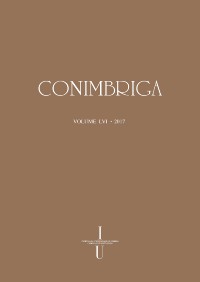Please use this identifier to cite or link to this item:
https://hdl.handle.net/10316.2/91373| DC Field | Value | Language |
|---|---|---|
| dc.contributor.author | Alonso Burgos, Fernando | - |
| dc.date.accessioned | 2018-01-11T11:23:48Z | |
| dc.date.accessioned | 2020-09-23T01:27:26Z | - |
| dc.date.available | 2018-01-11T11:23:48Z | |
| dc.date.available | 2020-09-23T01:27:26Z | - |
| dc.date.issued | 2017 | - |
| dc.identifier.issn | 1647-8657 (PDF) | - |
| dc.identifier.issn | 0084-9189 | - |
| dc.identifier.uri | https://hdl.handle.net/10316.2/43446 | - |
| dc.description.abstract | El análisis arqueológico del potencial simbólico de los fenómenos de las sítulas castreñas permite abordar las dinámicas específicas en el tránsito del fin de la Edad del Hierro y el periodo posterior a la conquista efectiva romana (siglos I a. C. –I d. C.). Se trata de un registro material muy homogéneo, constatado principalmente a través de los restos de los moldes de fundición, entre la tradición atlántica y la innovación mediterránea tanto en lo tecnológico, como en lo decorativo y lo funcional. Se propone que la difusión del modelo material no tendría por qué haber ido acompañada de la expansión de un mismo sentido ni funcional ni simbólico. Muy al contrario, como demuestra la propia elaboración local en cada castro y la inexistencia de centros productores regionales, con la limitación consecuente de los intercambios, se trataría de una reapropiación a distintas velocidades del modelo con consecuencias divergentes en las formas de convivialidad. | spa |
| dc.description.abstract | The archaeological analysis of the symbolic potential of the Castro situlae phenomenon can address to the specific dynamics in the transition between Late Iron Age and Early Roman times (1st century BC-1st century AD). This material record is very homogeneous and it is founded primarily through the remains of the casting molds, between the Atlantic and the Mediterranean traditions both in technological innovation, and decorative and functional. Here I propose that the dissemination of material model would not have been necessarily accompanied by the expansion of the same or functional or symbolic sense. On the contrary, as evidenced by the local processing itself in each Castro settlement and the lack of regional production centers with the consequent limitation of exchanges, it would be an appropriation at different speeds model with divergent consequences in taking forms of conviviality. | eng |
| dc.language.iso | spa | - |
| dc.publisher | Imprensa da Universidade de Coimbra | - |
| dc.rights | open access | - |
| dc.subject | sítulas | - |
| dc.subject | castreño | - |
| dc.subject | s. I a. C. | - |
| dc.subject | convivialidad | - |
| dc.subject | presencia romana | - |
| dc.subject | Occidente ibérico | - |
| dc.subject | vajilla metálica tardorrepublicana romana | - |
| dc.subject | situlae | eng |
| dc.subject | Castro culture | eng |
| dc.subject | Late Iron Age | eng |
| dc.subject | conviviality | eng |
| dc.subject | Early Roman times | eng |
| dc.subject | Western Iberia | eng |
| dc.subject | Late Roman Republic metal crockery | eng |
| dc.title | Sítulas y banquetes divergentes en el mundo castreño del s. I a. C. | por |
| dc.title.alternative | Situlae and divergent feasts in the castro culture of the 1st century BC | por |
| dc.type | article | - |
| uc.publication.collection | Conimbriga vol. 56 | - |
| uc.publication.firstPage | 41 | - |
| uc.publication.lastPage | 73 | - |
| uc.publication.location | Coimbra | - |
| uc.publication.journalTitle | Conimbriga: Revista de Arqueologia | - |
| uc.publication.volume | 56 | por |
| dc.identifier.doi | 10.14195/1647-8657_56_2 | - |
| uc.publication.orderno | 2 | - |
| uc.publication.area | Artes e Humanidades | - |
| uc.publication.manifest | https://dl.uc.pt/json/iiif/10316.2/91373/235914/manifest?manifest=/json/iiif/10316.2/91373/235914/manifest | - |
| uc.publication.thumbnail | https://dl.uc.pt/retrieve/11532763 | - |
| item.fulltext | With Fulltext | - |
| item.grantfulltext | open | - |
| Appears in Collections: | Conimbriga | |
Files in This Item:
| File | Description | Size | Format | |
|---|---|---|---|---|
| situlas_y_banquetes_divergentes.pdf | 2.68 MB | Adobe PDF |  |
Items in DSpace are protected by copyright, with all rights reserved, unless otherwise indicated.
